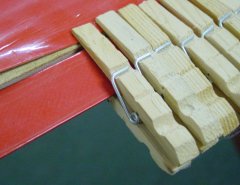Model Topics
Hints and Tips from Experience
The case for 5 cell airborne battery packs

This event occurred on
a forgetable New Year's Day - tests showed a cell had failed.

This event occurred on
a forgetable New Year's Day - tests showed a cell had failed.
This was a Marutaka Mustang for 60's which had already suffered a major catastrophe due to rearward CG. I obtained it and repaired it, fitted flaps, and was itching to fly it. After charging before flying, we took it to the field, and prepared for takeoff.
It flew well for for about 1 1/2 minutes, then I turned slightly left to swing wide, intending to start another right hand 180 turn.
It never stopped turning left, and dived in vertically. Control was completely lost without warning, a helpless feeling.
The result was bad, check the size of those pieces!
Subsequent checks showed that a cell had failed, but there was enough voltage for the short flight. If I had been using 5 cells, the crash may well not have occurred, even if the battery was OK when charging, but had failed in the air. I suspect the battery had died sometime before, but wasn't detected as the radio checked out OK on the brief (routine) tests.
I now use 5 cell packs for aircraft that I value. (IE, costly to replace!)
|
Why
use a five cell battery. When
a cell in the battery fails due to an internal short circuit, (the
most common form of cell failure), the battery will still deliver
power, but at a reduced voltage. In the case of a four cell pack,
the battery voltage would be 3.6 rather than 4.8 volts. This lower
voltage may be insufficient to power the RX and servos with the inevitable
loss of the aircraft. Reproduced
here with permission. |
Footnote.....I'm trying to locate the old film of the original crash. When I knew a crash was inevitable, I hit the slow motion button, and got it at 120 frames per second. It's a good example of flying with the cg too far back.
I'll put up either the clip, or frame grabs. Check back!
Simple Z bends! Just drill a hole or two in pliers to set the depths!
Make the first bendInsert into a hole, and bend again.Voila!
A perfect Z bend.
TIP: Use wire more substantial than a paper clip!
Reverse the springs of clothes pegs for more reach in difficult jobs........

Here, the pegs are being used to re-glue veneer to a wing, having the extra reach
to grip beyond the aileron.
More topics coming, keep watching.
Home